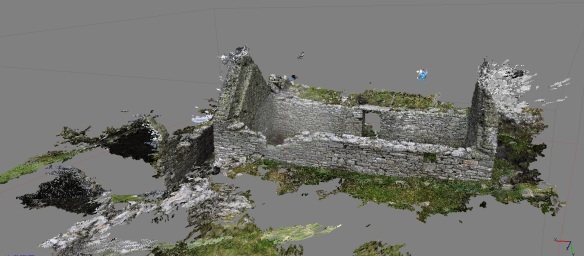John Scott of the Bressay History Group writes on when ACCORD came to Shetland to record the old township of Cullingsburgh on the island of Bressay…
The 8th October saw Bernard Redman, John Scott, Jane Manson, Beatrice Lowe and Chris Dyer of the Bressay History Group at the Bressay Heritage Centre waiting apprehensively for the indomitable two, Mhairi Maxwell and Cara Jones, who had arrived in Lerwick 27 hours later than they intended due to high seas. We sat down for the afternoon while Mhairi introduced the ideas behind photogrammetry and RTI and how in practice it all worked. Sounded like magic but she did not look like a witch so was spared. Then Cara asked each of us about our origins and interests and how we came to be living in Bressay. One answer being “Mum and Dad must have been too close in bed”. We also realised that our group was part of the research project, so we would be sharing our work with others. However, the round the table start was good as the next morning we set out for the site knowing each other better (and Cara feeling a lot better) and what we were going to tackle.

Jane Manson of the Bressay History group telling us all about Cullingsburgh Manse and how her relative was the last to live here in this township sometime in the 18th Century.
The site was at Cullingsburgh on the East side of Bressay. Multilayered archaeology of prehistoric field divisions topped by bronze age Burnt Mounds, an iron age Broch, a pictish carved stone, norse longhouses, the medieval cross kirk of St Mary and an abandoned crofting township. An area we, the Bressay History Group, have long intended to survey and explore. It is a green and fertile peninsula with low rocky shores home to seals and otters, a wildflower heaven on a summer’s day, open to the north wind in winter. Our chosen targets were a 1636 grave stone and the roofless manse in the township.
The grave stone of Commander Claes Jansen Bruyn
Within the kirkyard lies this memorial stone to the Commander of the Amboina, a vessel of the Dutch East India Company. She had sailed as escort from Surat in the Indian Ocean on 9th February 1636, had been delayed so missed the Dutch convoy at the Cape of Good Hope, left Table Bay on 9th May for a terrible voyage of headwinds and disease amongst the crew. The Amboina turned up in the Bressay Sound on 24th August with 29 of her crew perished, her Commander dying and only “20 healthy men remained, who, not being able to govern the ship, have, with great good fortune, reached harbour.” Commander Bruyn died on 27th August. Later the memorial stone must have been shipped from Holland to mark his grave here at Cullingsburgh.

RTI image of Commander Claes Jansen Bruyn’s crest on his grave, at Cullingsburgh kirk. He died 27th August 1636. It is now much eroded, if you look closely RTI has revealed the swan on the shield and enhanced the details of the fleur de lis.
The grave stone was recorded in the Inventory of Ancient Monuments in 1928 and it is evident that the surface has been eroded since then. We decided to use the magic arts of RTI to record its present state and decipher the lettering and design which can no longer be clear to the naked eye. Mhairi persuaded us to mount the camera on its tripod over the grave slab, place the shiny ball, take up the torches and envelope ourselves in a green tarpaulin. No stranger site has been seen in the kirkyard for many moons. We followed her instructions processing on the computer the results.
The Manse of Cullingsburgh

Jane Manson and John Scott with the magic pole capturing the photographs of Cullingburgh Manse with the Magic Pole (!) for our 3D model.
This building stands amongst the croft houses of similar size. We think that the last Minister to live at Cunningsburgh removed about 1737. We know that the last inhabitant of the house was Lowrie Manson who died in 1897. This was the end of human occupation of the township. We decided to record the building by photogrammetry. Using three cameras, one atop the pole and recorded on the computer, we took some 900 photos. We then collected ourselves and our kit and headed back to the shelter of the Heritage centre for lunch and the afternoon.
Here we fed in all the photos into the two programmes on the computer, which instead of bursting into flames began to hum away to itself. Slowly the photogrammetrical image of the Manse began to emerge and we could look all round it from any direction flying and hovering wherever we wished. The image grew in detail to a remarkable degree. We did likewise with the RTI programme and eventually received the clearly decipherable images of the family crest and lettering.
The Bressay group found the whole exercise a stimulating and exciting experience. We will build on it. We do wish to thank Mhairi and Cara for their patience, brilliance and good company.
John Scott


